Have you visited your Google Now Topics page? You should if you want to get a peek at how Google is translating queries into topics, which is at the core of the Hummingbird Update.
Google Now Topics
If you are in the United States and have Google Web History turned on you can go to your Google Now Topics page and see your query and click behavior turned into specific topics.
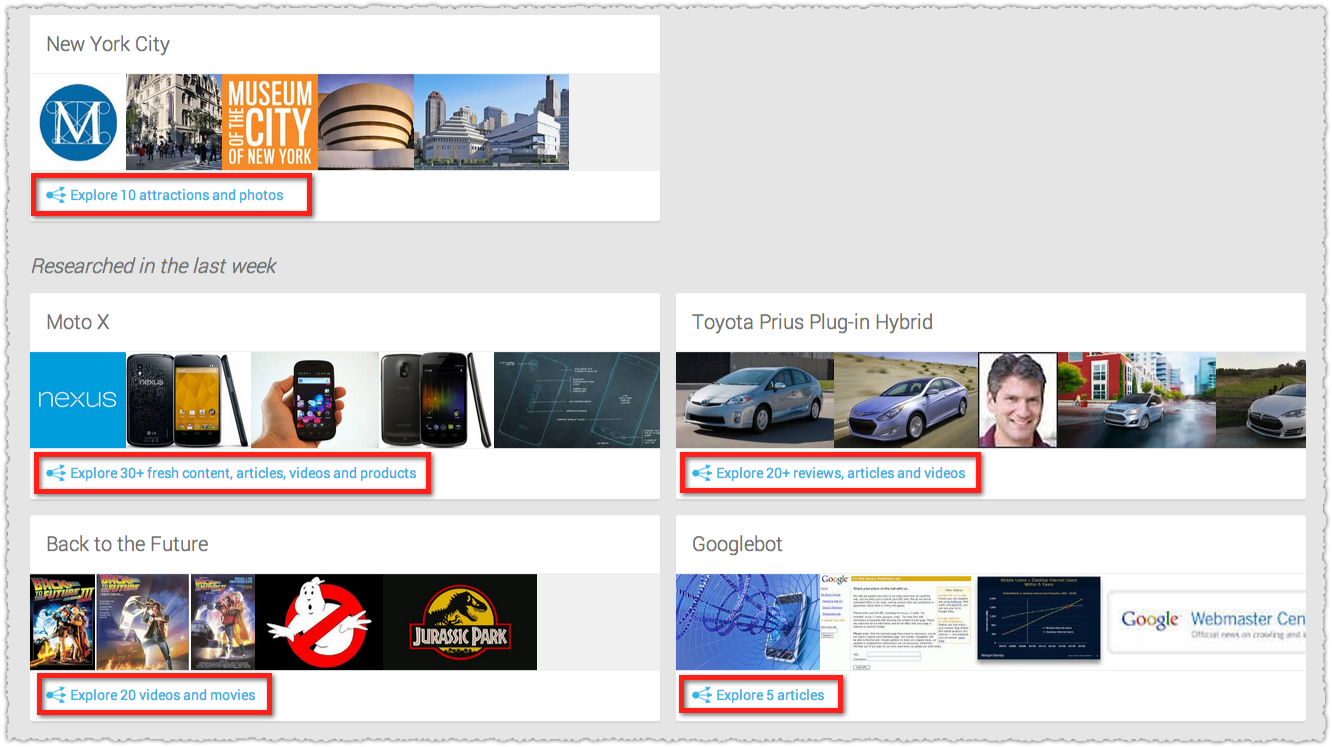
This is what my Google Now Topics page looked like a few weeks back. It shows specific topics that I’ve researched in the last day, week and month. If you’re unfamiliar with this page this alone might be eye opening. But it gets even more interesting when you look at the options under each topic.
Topic Intent
The types of content offered under each topic is different.
Why is this exciting? To me it shows that Google understands the intent behind each topic. So the topic of New York City brings up ‘attractions and photos’ while the topic of Googlebot just brings up ‘articles’. Google clearly understands that Back to the Future is a movie and that I’d want reviews for the Toyota Prius Plug-in Hybrid.
In essence, words map to a topic which in turn tells Google what type of content should most likely be returned. You can see how these topics were likely generated by looking back at Web History.
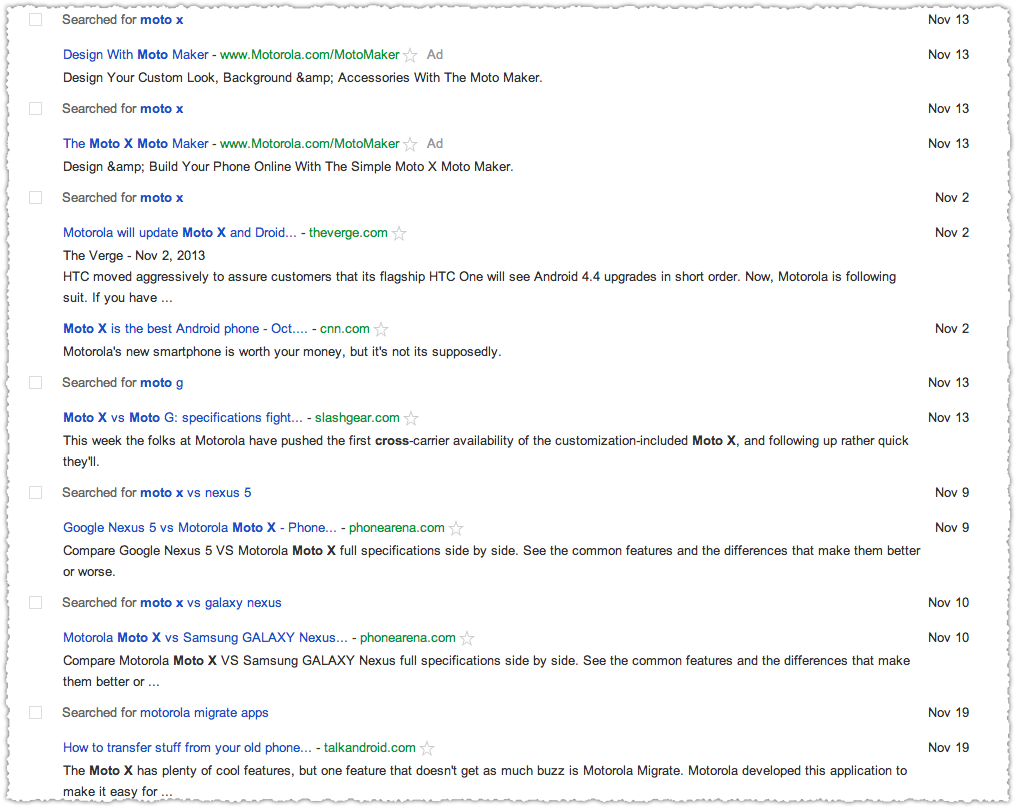
This part of my web history likely triggered a Moto X topic. I used the specific term ‘Moto X’ a number of times in a query which made it very easy to identify. (I did wind up getting the Moto X and love it.)
Tripping Google Now Topics
When I first saw this page back in March and then again in June I wanted to start playing around with what combination of queries would produce a Google Now Topic. However, I’ve been so busy with client work that I never got a chance to do that until now.
Here’s what I did. Logged into my Google account and using Chrome I tried the following series of queries (without clicking through on any results) at 1:30pm on November 13th.
the stranger
allentown
downeaster alexa
big shot
pressure
uptown girl
piano man
But nothing ever showed up in Google Now Topics. So I took a similar set of terms but this time engaged with the results at 8:35am on November 16th.
piano man (clicked through on Wikipedia)
uptown girl (clicked through on YouTube)
pressure (no click)
big shot (clicked through on YouTube)
the stranger lyrics (clicked through on atozlyrics, then YouTube)
scenes from an italian restaurant (no click)
Then at 9:20am a new Google Now Topic shows up!
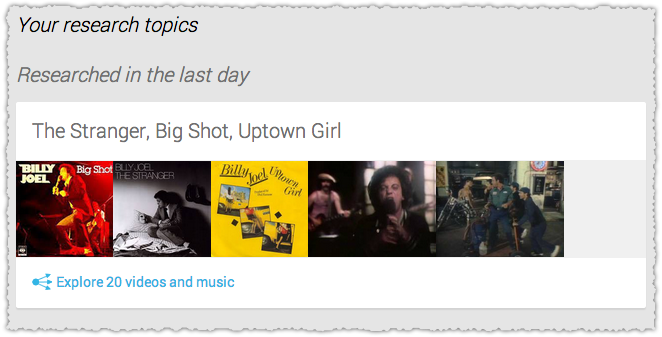
Interestingly it understands that this is about music but it hasn’t made a direct connection to Billy Joel. I had purposefully not used his name in the queries to see if Google Now Topics would return him as the topic instead of just songs. Maybe Google knows but I had sort of hoped to get a Billy Joel topic to render and think that might be the better result.
YouTube Categories
Engagement certainly seems to count based on my limited tests. But I couldn’t help but notice the every one of the songs in that Google Now Topic was also a YouTube click. Could I get a Google Now Topic to render without a YouTube click.
The next morning I tried again with a series of queries at 7:04am.
shake it up (no click)
my best friend’s girl (lyricsfreak click)
let the good times roll (click on Wikipeida, click to disambiguated song)
hello again (no click)
just what i needed (lastfm click)
tonight she comes (songmeanings click)
shake it up lyrics (azlyrics click)
At 10:04 nothing showed up so I decided to try another search.
let the good times roll (clicked on YouTube)
At 10:59 nothing showed up and I was getting antsy, which was probably not smart. I should have waited! But instead I performed another query.
the cars (clicked on knowledge graph result for Ric Ocasek)
And at 12:04 I get a new Google Now Topic.
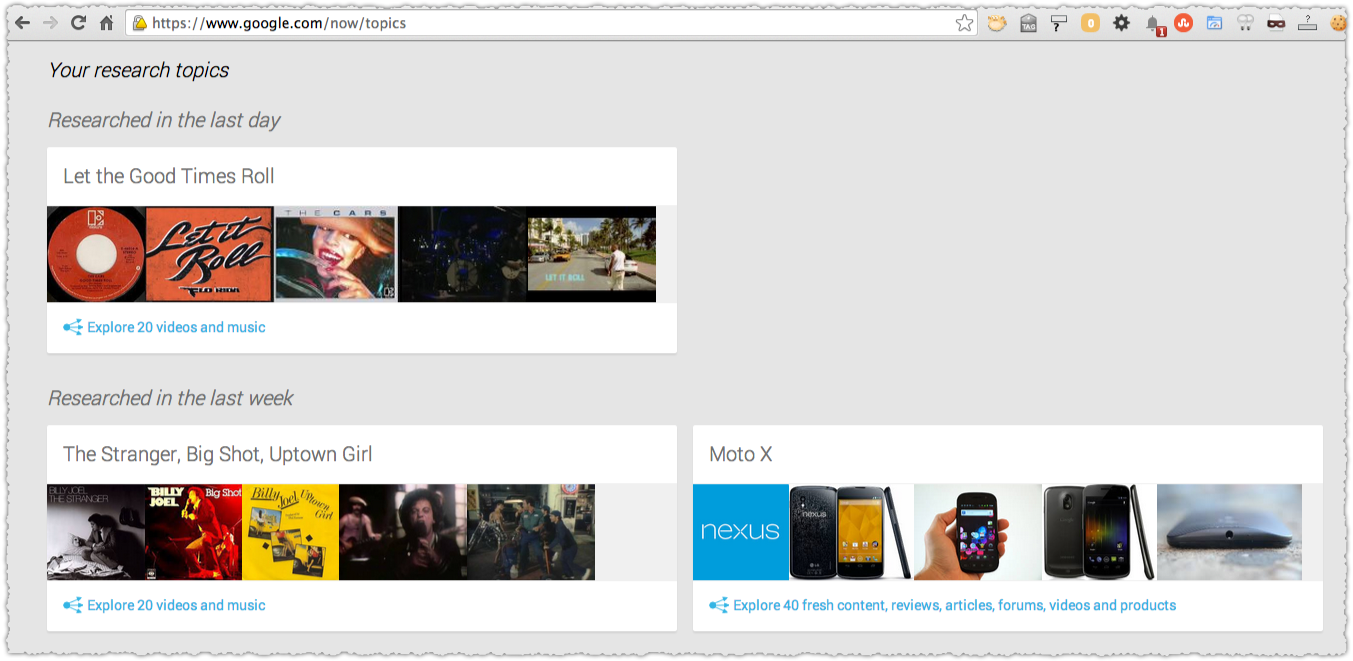
I’m guessing that if I’d waited a bit longer after my YouTube click that this would have appeared, regardless of the click on the knowledge graph result. It seems that YouTube is a pretty important part of the equation. It’s not the only way to generate a Google Now Topic but it’s one of the faster ways to do so right now.
Perhaps it’s easier to identify the topic because of the more rigid categorization on YouTube?
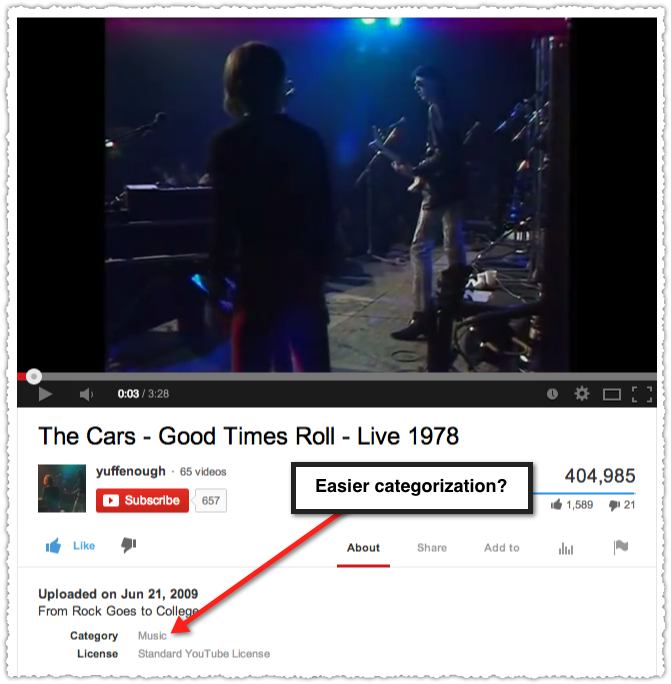
I didn’t have time to do more research here but am hoping others might begin to compile a larger corpus of tests so we can tease out some conclusions.
Topic Stickiness
I got busy again and by the time I was ready to write this piece I found that my topics had changed.
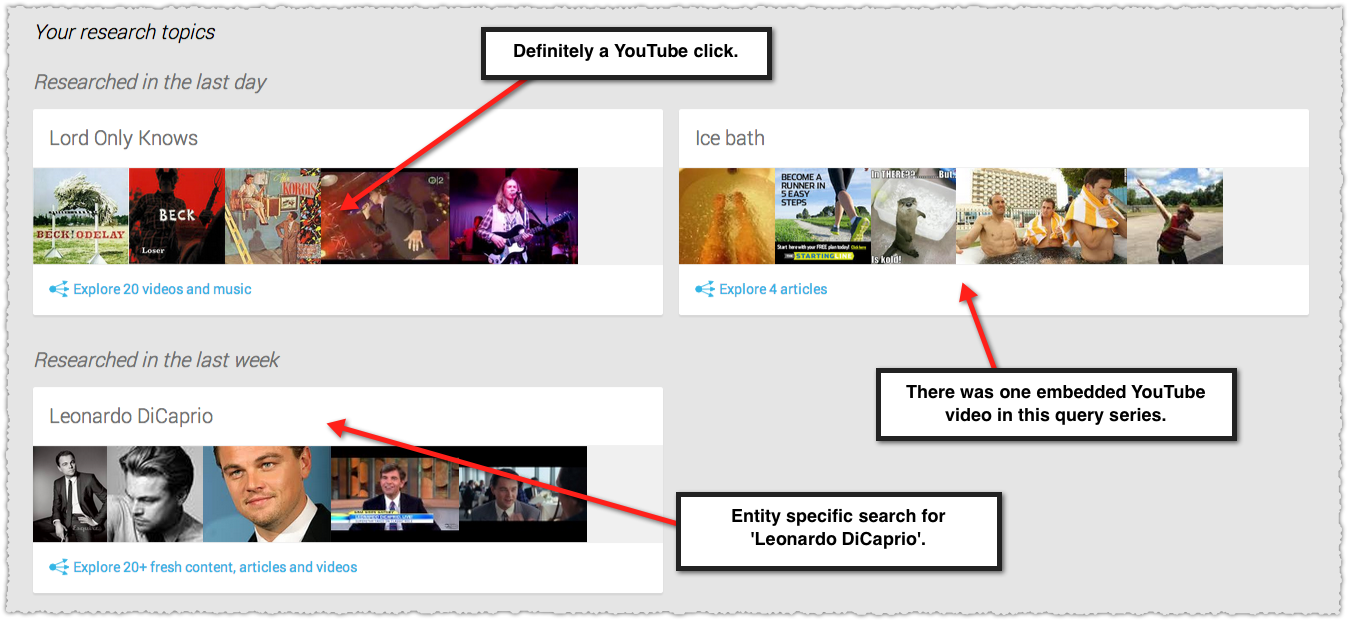
It was fairly easy to deduce why each had been produced, though the Ice Bath result could have been simply from a series of queries. But what was even more interesting was what my Google Now Topics looked like this morning.
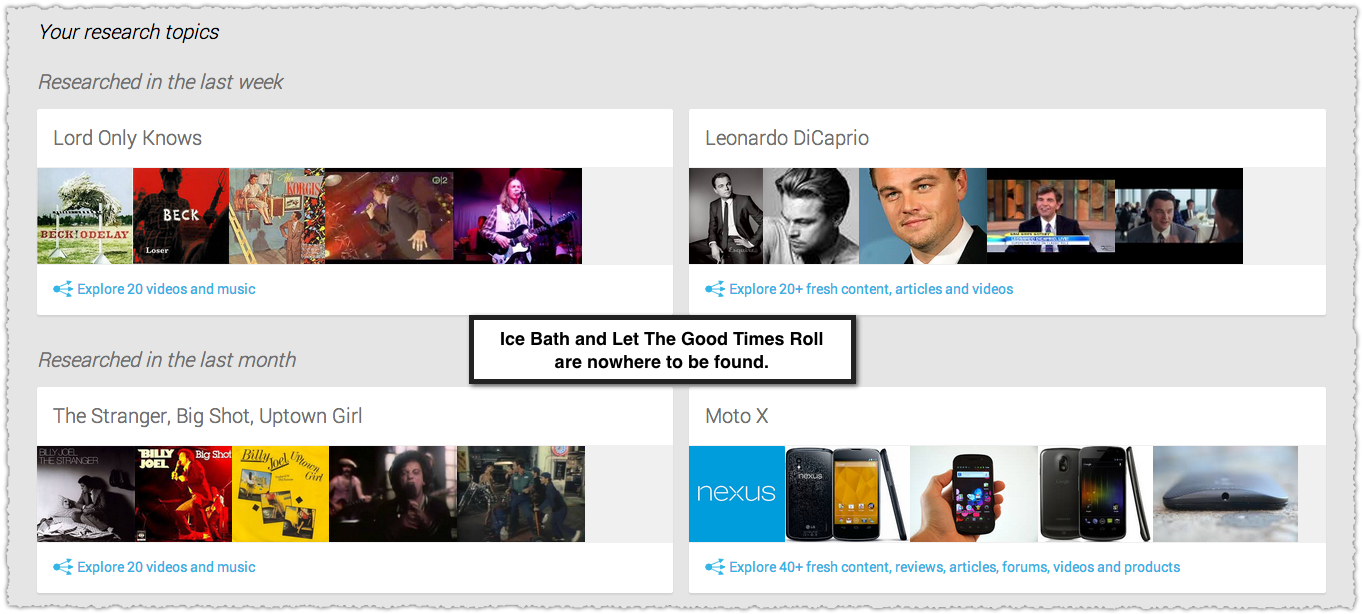
Some of my previous topics are gone! Both Ice Bath and Let The Good Times Roll are nowhere to be found. This seems to indicate that there’s a depth of interaction and distance from event (time) factor involved in identifying relevant topics.
It would make sense for Google to identify intent that was more consistent from intent that was more ephemeral. I was interested in ice baths because my daughter has some plantar fascia issues. But I’ve never researched it before and likely (fingers crossed) won’t again. So it would make sense to drop it.
There are a number of ways that Google could determine which topics are more important to a user, including frequency of searching, query chains, depth of interaction as well as type and variety of content.
Google Now Topics and Hummingbird

My analysis of the Hummingbird Update focused largely on the ability to improve topic modeling through a combination of traditional text analysis natural and entity detection.
Google Now Topics looks like a Hummingbird learning lab.
Watching how queries and click behavior turn into topics (there’s that word again) and what types of content are displayed for each topic is a window into Google’s evolving abilities and application of entities into search results.
It may not be the full picture of what’s going on but there’s enough here to put a lot of paint on the canvass.
TL;DR
Google Now Topics provide a glimpse into the Hummingbird Update by showing how Google takes words, queries and behavior and turns them into topics with defined intent.
The Next Post: Stop Carly Rae Content Marketing
The Previous Post: What Does The Hummingbird Say?

5 trackbacks/pingbacks
Comments About Google Now Topics
// 11 comments so far.
Max Minzer // November 26th 2013
I clearly remember my first “shock” with this when I checked something in Google and on Wikipedia page, read it for a minute or so and then went downstairs. Checked Google Now on my phone and the topic WAS THERE! Almost instantly…
I didn’t record any of that – time, search path, etc. and got used to this happen over time. I’ll start to notice these details now thanks to this post, AJ.
P.S.
Got Moto X too recently. “Hey Google Now! What does the hummingbird say?”
AJ Kohn // November 26th 2013
Thanks Max. I didn’t even go that far into the mobile side of Google Now, which really is amazing. At some point it’ll be interesting to see if local searches done via mobile will trigger different types of Google Now Topics.
So much to test and so little time to do it 🙂
Gregory Smith // November 26th 2013
AJ,
This makes for one heck of a discussion. Wonderful read bud.
Thanks again,
Greg Smith
AJ Kohn // November 26th 2013
Thanks Greg. It’s definitely a fascinating thing to keep an eye on.
Valerie Lynn // November 26th 2013
I’m in -and particularly interested in what Topics will surface as a result of the MotoX and voice commands. How Google will tease out relevance given the combinations of GPS data, Home and Work info with Search will be interesting.
AJ Kohn // November 26th 2013
Yes Valerie. I didn’t even really scratch the surface on how mobile queries and context could impact Google Now Topics. But Google will obviously be trying to understand topics and intent using those factors as well.
Mel // November 27th 2013
Really interesting! Hoping Google brings this to the UK shortly so I can have a look!
Grant Simmons // November 27th 2013
Brilliant (simple) research to help understand complex concept…
One key element here is engagement aspect of first SERP click, query modification and query chains… And cross-device continuity… Shows power of logged in experience and potential of device / location / time / query context opportunities for understanding of query intent.
Great stuff AJ
AJ Kohn // November 27th 2013
Thanks Grant and I completely agree that the device / location / time / query context opportunities are very interesting.
Warren // November 27th 2013
Hi AJ, very interesting. I like the idea of a broader test and might consider testing other parts of google along the same vein of thought to what you are describing here with Google now. Particularly g+ Searches, news searches, image searches , or even could G mail content be used to connect entities? My hunch is that potentially all might be used for better topic modeling. From the test described here, it supports that there is a relationship between YouTube click interactions and google now, which is something I’ve observed since about the end of August this year. Would be really interesting if you could replicate without any of the YouTube clicks.
AJ Kohn // November 27th 2013
More tests are certainly needed Warren. I actually have gotten Google Now Topics to render without a YouTube click. The Leo Dicaprio and New York City in particular were without any YouTube interaction.
But in both of those instances (and the Moto X) example, I used the specific entity name in my query which makes it super easy for Google to identify. I was more interested in how it might infer a topic.
I’m fairly certain image search does trip Google Now Topics since some of my topics are a result of me searching for images for a recent blog post. However, I couldn’t replicate that during my testing period so I didn’t include it in the post. (I’m a bit of stickler on my own due diligence.)
Hopefully we can get more folks doing some testing and confirming what does and doesn’t create these topics.
Sorry, comments for this entry are closed at this time.
You can follow any responses to this entry via its RSS comments feed.